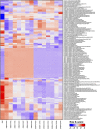Robustness of radiomic features in 123I-ioflupane-dopamine transporter single-photon emission computer tomography scan
- PMID: 38603674
- PMCID: PMC11008844
- DOI: 10.1371/journal.pone.0301978
Robustness of radiomic features in 123I-ioflupane-dopamine transporter single-photon emission computer tomography scan
Abstract
Radiomic features are usually used to predict target variables such as the absence or presence of a disease, treatment response, or time to symptom progression. One of the potential clinical applications is in patients with Parkinson's disease. Robust radiomic features for this specific imaging method have not yet been identified, which is necessary for proper feature selection. Thus, we are assessing the robustness of radiomic features in dopamine transporter imaging (DaT). For this study, we made an anthropomorphic head phantom with tissue heterogeneity using a personal 3D printer (polylactide 82% infill); the bone was subsequently reproduced with plaster. A surgical cotton ball with radiotracer (123I-ioflupane) was inserted. Scans were performed on the two-detector hybrid camera with acquisition parameters corresponding to international guidelines for DaT single photon emission tomography (SPECT). Reconstruction of SPECT was performed on a clinical workstation with iterative algorithms. Open-source LifeX software was used to extract 134 radiomic features. Statistical analysis was made in RStudio using the intraclass correlation coefficient (ICC) and coefficient of variation (COV). Overall, radiomic features in different reconstruction parameters showed a moderate reproducibility rate (ICC = 0.636, p <0.01). Assessment of ICC and COV within CT attenuation correction (CTAC) and non-attenuation correction (NAC) groups and within particular feature classes showed an excellent reproducibility rate (ICC > 0.9, p < 0.01), except for an intensity-based NAC group, where radiomic features showed a good repeatability rate (ICC = 0.893, p <0.01). By our results, CTAC becomes the main threat to feature stability. However, many radiomic features were sensitive to the selected reconstruction algorithm irrespectively to the attenuation correction. Radiomic features extracted from DaT-SPECT showed moderate to excellent reproducibility rates. These results make them suitable for clinical practice and human studies, but awareness of feature selection should be held, as some radiomic features are more robust than others.
Copyright: © 2024 Laskov et al. This is an open access article distributed under the terms of the Creative Commons Attribution License, which permits unrestricted use, distribution, and reproduction in any medium, provided the original author and source are credited.
Conflict of interest statement
The authors have declared that no competing interests exist.
Figures


References
-
- Group PS. A Randomized Controlled Trial Comparing Pramipexole with Levodopa in Early Parkinson’s Disease: Design and Methods of the CALM-PD Study. Clin Neuropharmacol. 2000. Feb;23(1):34. - PubMed
MeSH terms
Substances
LinkOut - more resources
Full Text Sources

